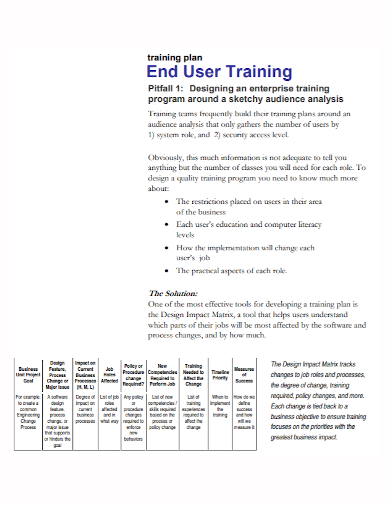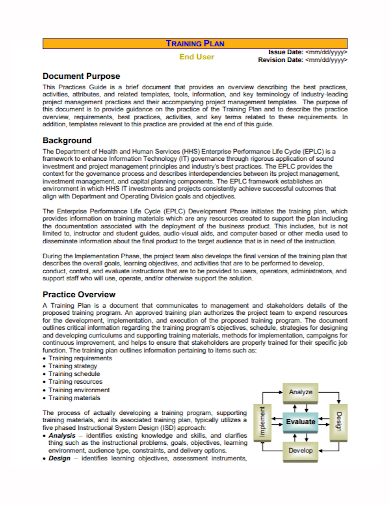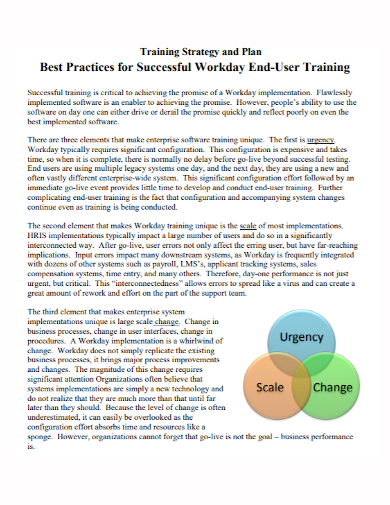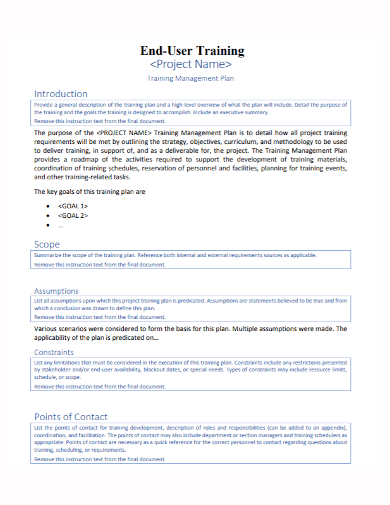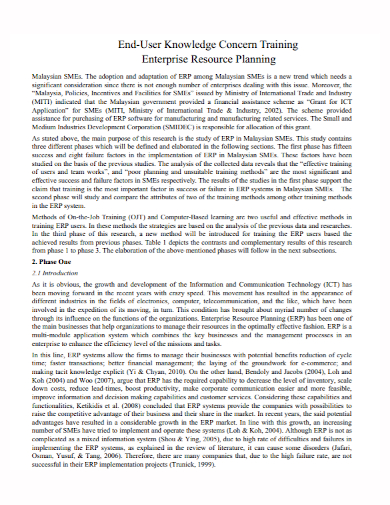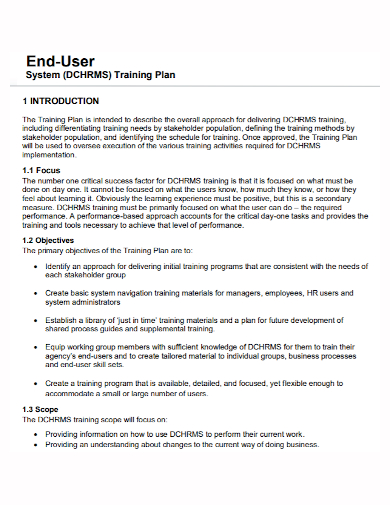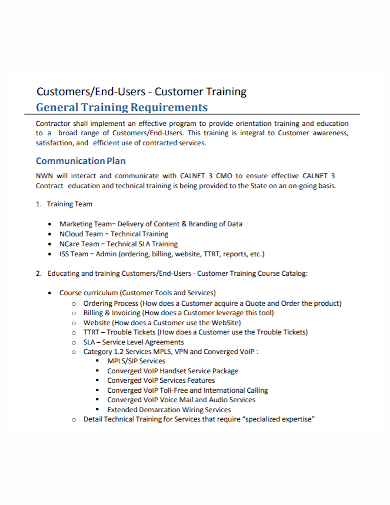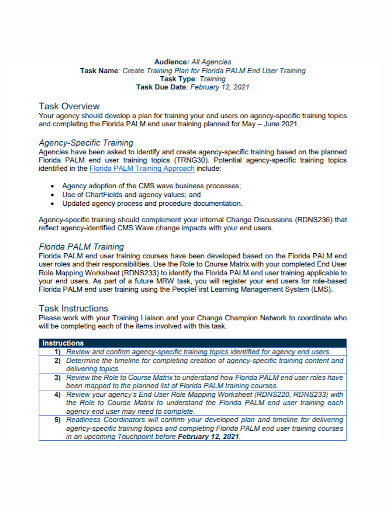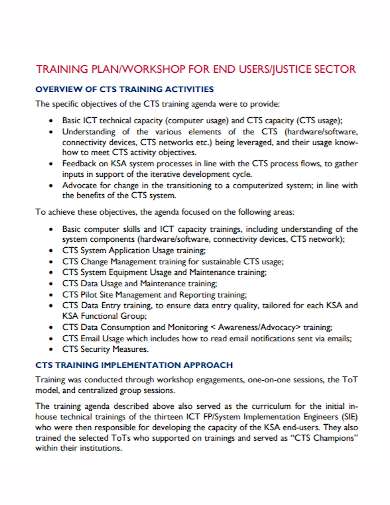Maybe you’re in charge of implementing a major software change in your company, or you’re about to move all of your documents to a new system. To be successful, large-scale changes like these, which affect all employees at your company, require everyone’s support. It’s like a house of cards; one disgruntled employee can throw the entire project into disarray. Your employees are your end-users or anyone who has to use the technology or software you’re putting in place. Before you begin training your end-users, figure out who they are, what level of technology literacy they have, and what roadblocks you need to remove to make the implementation go more smoothly.
End-User Training Plan Samples
1. End-User Training Plan Template
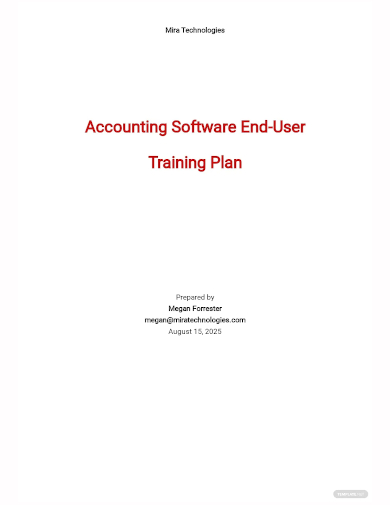
2. End-User Training Plan
3. End-User Analysis Training Plan
4. End-User License Training Plan
5. End-User Training Strategy Plan
6. End-User Project Training Plan
7. End-User Training Enterprise Resource Plan
8. End-User System Training Plan
9. End-User Training Communication Plan
10. End-User Task Training Plan
11. End-User Workshop Training Plan
Keys to Successful Implementation of End-User Training
- Set training goals – The first goal of providing end-user software training is to minimize any productivity losses caused by the software transition. This means you need to get them up to the skill level required to do their jobs at least as quickly and accurately as they did with the old software as soon as possible.
- Try to assess end-user needs – Evaluation of the technical skill level(s) of those who will actually use the software on a daily basis is an important part of creating your training plan.
- Training delivery methods
– Individualized instruction with a hands-on instructor
– Instructor-led training in a hands-on classroom setting
– A group demonstration in the style of a seminar
– Computer-Based Instruction (CBT)
– Self-paced training based on a book - Create a training program – End-user training that is tailored to your organization’s use of the software is more effective and memorable than generic lessons.
- Make your training program scalable – A scalable training program can accommodate both small groups of users (for example, when new employees join the company and need to be trained on the software) and large groups of users (for example, when new employees join the company and need to be trained on the software) (as is necessary for an organization-wide rollout of a new product).
Employees will feel more comfortable using new software or technology if they have participated in training prior to the system’s implementation. There are several approaches to training your staff as end-users of the software or technology that the project is implementing, including using the “train-the-trainer” approach, which involves creating super users from your end-users to train the rest of your staff, outsourcing it to a training partner, or setting aside time for asynchronous online learning.
You can also combine the two and use online learning systems to quickly create and manage an online course to train and manage your employees. This allows you to explain how the software or process is used in your company, and it’s simple to incorporate into your new hire onboarding process or to upskill existing employees. This can save you a lot of time because the training is already completed and ready to use.
FAQs
What are some of the benefits that a company gains from end-user training?
1. Work that is more efficient and less prone to errors. A better understanding of the software reduces errors and ensures that work is completed efficiently.
2. Employees who are invested and empowered. Participation in group training sessions is encouraged. Employees are more invested and empowered to learn the fundamental skills when they are trained in groups.
3. A better sense of worth. Employee morale is boosted by training because the user feels more valuable in the company. The trained employee becomes a trusted source of software knowledge and can assist others when needed.
4. Productivity has increased. Training sessions elicit discussions that serve as troubleshooting forums. Employees have the opportunity to speak with other industry professionals and share ideas on how to use the program more efficiently and solve common problems, resulting in increased productivity.
Why is it important to assess learning requirements?
The success of any new project implementation involving new software or technology is dependent in part on how quickly staff can learn to use the new system. Even if you have the best system in place, you will never be successful if people are unwilling or unable to use it. Major system upgrades result in significant changes in how users work, and providing the appropriate technology training can assist users in adapting to those changes.
If you want to see more samples and formats, check out end-user training plan samples and templates provided in the article for your reference.
Related Posts
FREE 7+ Fashion Business Plan Samples in PDF
FREE 10+ Sprint Planning Samples In MS Word | Google Docs | PDF
FREE 10+ Wedding Planning Samples in MS Word | Apple Pages | Powerpoint | PDF
FREE 9+ Monthly Study Planner Samples in PSD | Illustrator | InDesign | PDF
FREE 9+ Sample Curriculum Planning Templates in PDF | MS Word
FREE 10+ Teacher Development Plan Samples in MS Word | Google Docs | Apple Pages | PDF
FREE 10+ Basketball Practice Plan Samples in PDF
FREE 12+ School Business Plan Samples in PDF | MS Word | Apple Pages | Google Docs
FREE 7+ Client Strategic Plan Samples in PDF | MS Word
FREE 11+ Trucking Business Plan Templates in PDF | MS Word | Google Docs | Pages
FREE 7+ Small Hotel Business Plan Samples PDF | MS Word | Apple Pages | Google Docs
FREE 14+ Bakery Business Plans in MS Word | PDF | Google Docs | Pages
FREE 4+ Yearly Lesson Plan Samples in PDF
FREE 50+ Strategic Planning Samples in Google Docs | Pages | PDF | MS Word
FREE 10+ Construction Project Plan Samples in MS Word | Google Docs | Apple Pages | PDF

